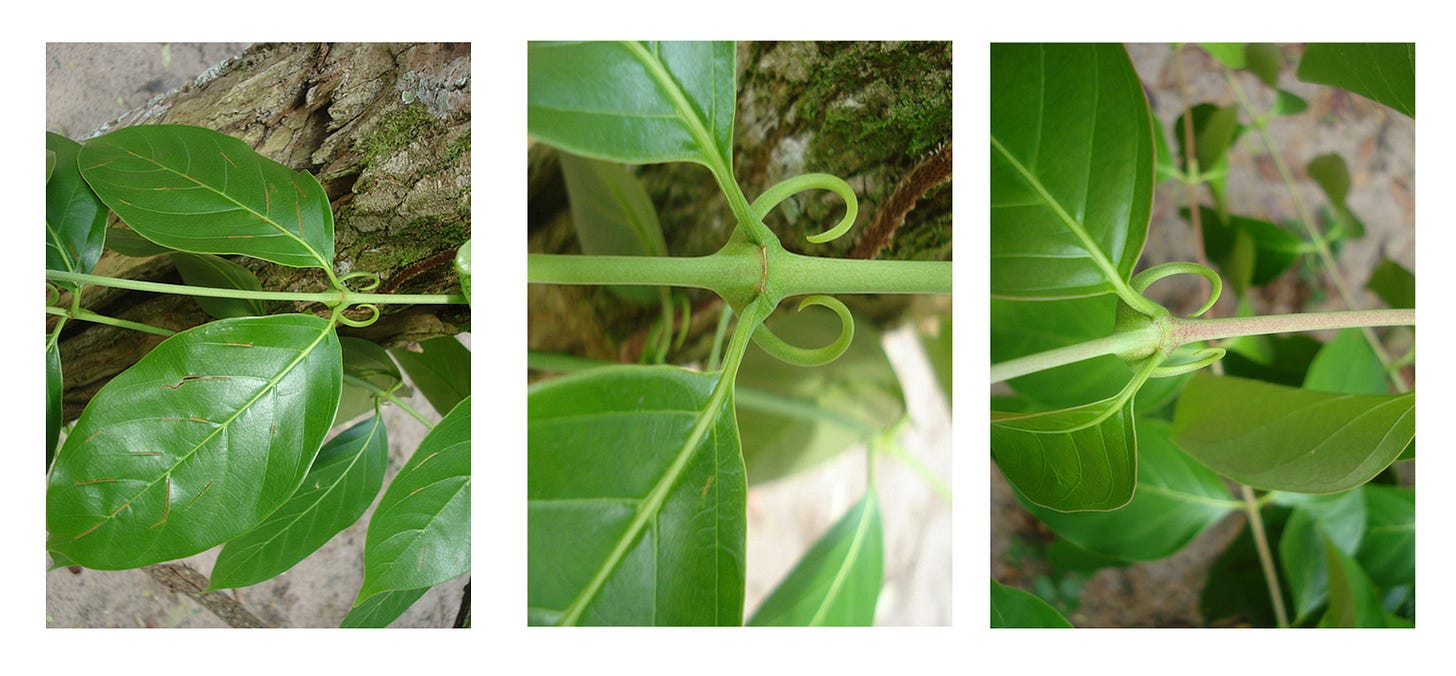Cat's Claw
I first encountered this plant in the Amazon rainforest around 25 years ago. What have we learned about it since?
I have a bottle of Captain Morgan rum in the bookcase of my home office. Take a swig, and you’ll note that it doesn’t taste like the rum you expect, but is somewhat earthy, woody, and bitter. Looking closer, you’ll see a bundle of long, skinny slips of wood floating in the dark amber liquid. This is actually not wood, but root bark, which is used in traditional medical treatments for aches and pains. The bark is from an Amazonian cure-all, locally known as uña de gato, or Cat’s claw. The plant's scientific name is Uncaria tomentosa, and it is from the same plant family (Rubiaceae) where we find pharmacological treasures like the coffee plant!

When I first arrived in Iquitos, Peru, in 1999—gateway to the Peruvian Amazon—I noted that this plant was popular among herb vendors in the floating Belén market. It is prepared either as a decoction (by boiling in water) or an alcoholic tincture (steeped in rum) and drunk. Local healers, working far from the city deep in the tributaries of the Amazon, use it for various ailments, treating general aches and pains, rheumatism, and many other applications. In other words, it is a popular cure-all or panacea which targets a variety of inflammatory diseases.
Nearly 25 years have passed since I first learned of this medicinal plant. We had little scientific evidence in support of these healing claims back then. In this post, I examine some of the new lessons learned about Cat's claw's safety, efficacy, and utility.
Laboratory Studies
Cat’s claw has been studied for many different applications across in vitro (test-tube) and in vivo (animal) studies.
Bone Loss
A study on osteoclastic bone loss due to periodontitis (gum disease) found that Cat’s claw extract on rats shows promise in treating periodontitis via anti-inflammatory and antiresorptive activities. Further, they identified some of the potentially responsible bioactive molecules of the alkaloid chemical class.

Memory
A study on cognition, memory, and learning was performed on middle-aged rats. The underlying hypothesis of the study was that as aging accelerates neurodegeneration, treatment with neuroprotective agents might help overcome this challenge. Different groups of middle-aged rats were treated with three doses of Cat’s claw extract for a month or a year. The major findings were that the extracts improved cognition, memory, and learning and minimized DNA damage in rat brains.
Clinical Studies
Cat’s claw has been assessed in some clinical trials tested in humans.
Rheumatoid Arthritis
A randomized double-blind trial examined the efficacy of Cat’s claw extract in treating rheumatoid arthritis. The study evaluated 40 patients, assessing the response to extract or placebo. While this was a small pilot study, there was a significant reduction in painful joints (53.2% vs. 24.1%) in the extract-treated group compared to the placebo.
Denture Stomatitis
A randomized clinical study of 50 participants examined the efficacy of Cat’s claw extract gel in treating denture stomatitis, a condition of swelling, redness, and mouth tenderness associated with denture use. The treatment group was compared to an antifungal gel and placebo groups. The major finding was that the Cat’s claw extract was as effective as the antifungal gel for treating this condition.
Safety
Some concerns have been raised with regard to herb-drug interactions for this medicinal plant. One review of case reports of adverse interactions between antiretroviral drugs (e.g., medications for HIV) and herbs found that Cat’s claw can significantly increase the levels of certain antiretroviral drugs in the body and may cause adverse effects in these patients as a result.
The Takeaway
Cat’s claw root bark continues to serve as an important medicine in the healing traditions of the Peruvian Amazon. Recent studies performed in animals and humans indicate that Cat’s claw may have potent anti-inflammatory properties relevant to several conditions. However, much more research is needed to understand which molecules from the plant are responsible for these observed effects and to determine how these may be developed into a standardized therapy for specific indications. Some significant safety concerns exist, as Cat’s claw may interfere with how your body processes certain prescription medications. Always talk to your doctor before taking any herbal supplement with any prescription medicines.
I look forward to future clinical studies that hone in on these questions and evaluate the full medical potential of this fascinating plant.
Yours in health, Dr. Quave
Cassandra L. Quave, Ph.D. is a scientist, author, speaker, podcast host, wife, mother, explorer, and professor at Emory University School of Medicine. She teaches college courses and leads a group of research scientists studying medicinal plants to find new life-saving drugs from nature. She hosts the Foodie Pharmacology podcast and writes the Nature’s Pharmacy newsletter to share the science behind natural medicines. To support her effort, consider a paid or founding subscription, with founding members receiving an autographed 1st edition hardcover copy of her book, The Plant Hunter.
Available in hardcover, paperback, audio, and e-book formats!







So love reading your posts! Being a part of the herb community I am so grateful for your global journeys thru the years and bringing scientific validity to what indigenous people have known and worked with for years. Thank you so much💕🙏
How interesting. I just learned that for a very long time, I have been conflating two unrelated plants with the same common name: Uncaria tomentosa and Senegalia greggii, both called cat claw, though the latter is commonly called cat claw acacia. Both are highly useful plants for indigenous people, the former for medicine, the latter mostly for handcrafts like baskets, and for food. It’s a good reminder of the importance of botanical names. Now I want to learn more about Uncaria tomentosa.